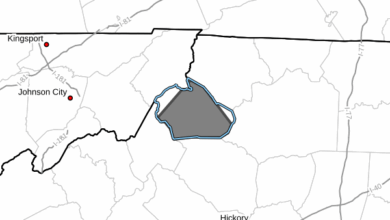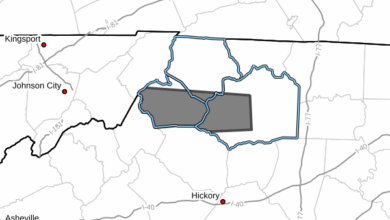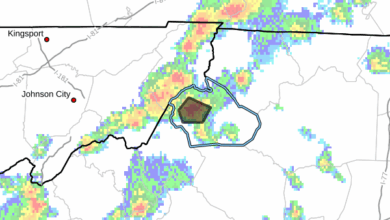Last Updated on October 2, 2022 6:05 pm
With temperatures already hitting the 30s in October, and snow forecast for Halloween night and into Saturday, it's a solid reminder that another High Country winter is just about upon us.
Local DOT and road officials that oversee winter snow removal are once again ready for Old Man Winter. Not only are these experienced officials on top of what could happen each winter, the material and crews are ready to go too.
Watauga County
On Wednesday October 8,2014 the Watauga NCDOT office conducted their annual “Snow Day” for DOT employees and DOT contractors. WataugaRoads.com was invited to sit in and see first hand how Watauga DOT is prepared for the coming winter.
16 NCDOT trucks and 12 contracted trucks will take on the task of keeping roads as clear as possible this winter. All 28 trucks have inbox spreaders and snow plows, and if conditions call for it then 4 motor-graders, 1 snow blower, 2 front end loaders and 3 push trucks are also available.
Crews begin clearing and treatment operations on “bare pavement routes” first. These routes are the main highways in the county that carries the volume of traffic.
Bare pavement Map: NCDOT. Click on map to view full scale *open in a new window*

Three new bare pavement routes will be added for the 2014-15 winter. They are: Candy Lane, George Triplett Road and the paved portion of Silverleaf Road in Zionville.
A concern this winter is the shorter supply of salt. Kevin Whittington, DOT Maintenance Engineer for Watauga, told WataugaRoads.com that an increase in snow and ice storms in non mountain counties last winter have created a much higher demand for salt this upcoming season than in the past several years. Between 500-700 tons of salt is used in Watauga County in a 24 hour period when conditions warrant.
For now shorter supplies of salt will not be an issue as Watauga DOT has 5,000 tons of salt in inventory, along with 15,000 gallons of salt brine. Shorter supplies could become a factor if this winter season produces more snow and/or ice than recent winters.
During the meeting Whittington made it clear that safety is always the top priority. Pointing to a memorial plaque for fallen DOT worker David Cook on the wall, Whittington reminded everyone “we don't want another one of these”. Cook was killed in the early morning hours of October 2, 2012 when a pickup struck him while he was sawing a downed tree across the road near Parkway School. “Resist the urge to get the job done quick” Whittington noted to the DOT drivers and contractors in attendance.
Boone
In Boone beets will once again help beat winter road issues, at least in part.
For the third winter season in a row beet juice will expand the efforts to keep streets treated for motorist. The beet juice is bought in loads of 4,500 gallons and will be mixed with salt brine at a 70/30 brine to juice ratio. Using the mixture allows melting as snow falls, and gives Town of Boone crews more time to get on their routes to apply the dry salt and slag.
Beet juice with salt brine can be applied at about half the rate of salt brine by itself. Salt brine alone is applied at 40-60 gallons per mile, however using the 70/30 blend it can be applied at 20-30 gallons per mile. Salt brine will melt down to 10 degrees but the beet juice added will melt down to -20 degrees.
Another big advantage is the beet juice mix will stay on the road up to 72 hours after application compared to 24 to 48 hours for the salt brine. With the beet juice mix the corrosion factor also lowers by 76%. The main culprit in corrosion is caused by the dust off just the brine mix when it dries.
Again this winter season Boone will be pre-wetting the dry salt and slag, with the juice, to help keep the dry material to stay on the pavement. By applying dry material by itself the lose is almost 40% to bouncing off pavement to the shoulder of the road. Eric Gustaveson, Interim Public Works Director for Boone, says that crews will pre-wet loads at a rate of 10 gallons of brine per ton of salt to help prevent bounce and splatter and start activation.
Boone began using beet juice for the first time in the winter of 2011 and was one of the first towns in North Carolina to do so.
Gustaveson also tells WataugaRoads.com that the town has a “full shed of salt”, which is around 800 tons and a purchase order for an additional 1000 tons. 200 tons of slag (a very fine gravel material) is on hand and 2,000 more tons is on order as or if needed. Public Works mixes salt to slag, 2 parts slag to 1 part salt, and makes brine as needed out of the salt they have.
The Boone Public Works Department maintains 43 miles of road or 86 lane miles.
Avery County
Jerry Combs, Avery County DOT Maintenance Manager, tells WataugaRoads.com that they generally start the winter season with approximately 3,000 tons of salt stockpiled and usually uses around 5,000 for the entire winter.
Combs notes a common problem in treating roads in the High Country, “the problem with pre-treating with brine is that most of our events start out as rain and it washes the brine from the road before it ever starts to snow”. Avery will have approximately 5,000 gallons of brine on hand for the winter.
A point that Combs also brought up was the possible use of calcium chloride. Calcium Chloride was widely used across the High Country at one point, and was combined with salt to increase the strength of both products. It has not been used as much in several years due to the cost and it's very corrosive to vehicles.
“All of this is pretty much what we start each winter with” added Combs. “We also mix our salt with sand or screenings for traction this is mostly on secondary paved roads that have north banks or in curves. We have about 5,000 tons of that on hand also”.
Below is a breakdown of winter weather equipment and supplies each county throughout Division 11 has available, as well as the number of miles of roads each is responsible for clearing. Information from NCDOT as of Nov 11, 2013.
Alleghany
– 455 miles
– 16 NCDOT plows, 1 contract plow
– 4 NCDOT motor graders, 3 contract motor graders
– 800 tons of salt stored
Ashe
– 805 miles
– 17 NCDOT plows, 9 contract plows
– 7 NCDOT motor graders, 7 contract motor graders
– 2,500 tons of salt stored
Avery
– 337 miles
– 13 NCDOT plows, 8 contract plows
– 5 motor graders, 2 contract motor graders
– 6,000 tons of salt stored
Caldwell
– 692 miles
– 13 NCDOT plows, 10 contract plows
– 2 motor graders, 7 motor graders
– 1,950 tons of salt available
Surry
– 1,138 miles
– 34 NCDOT plows, 14 contract trucks
– 5 NCDOT motor graders
– 2,200 tons of salt
Watauga
– 573 miles
– 20 NCDOT plows, 12 contract plows
– 4 NCDOT motor graders, 2 contract grader
– 6,000 tons of salt stored
Wilkes
– 1,329 miles
– 44 NCDOT plows, 7 contract plows
– 8 NCDOT motor graders, 9 contract grader
– 1,800 tons of salt stored
Yadkin
– 714 miles
– 16 NCDOT plows, 8 contract plows
– 3 NCDOT motor graders, 6 contract grader
– 800 tons of salt stored

















